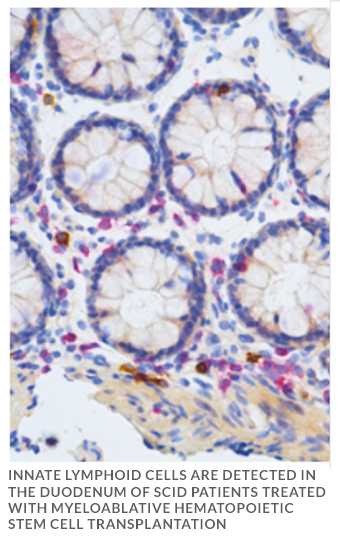A group of researchers and clinicians led by Professors Eric Vivier (CIML / CNRS, INSERM, AMU, AP-HM, Académie Nationale de Médecine, Institut Universitaire de France), Alain Fischer (INSERM, Institut Imagine, Hôpital Universitaire Necker-Enfants Malades / AP-HP, Collège de France) and Gérard Michel (Service d'Hématologie et d'Oncologie Pédiatrique de l'Hôpital de la Timone / AP-HM), demonstrated the for the first time in Nature Immunology.
Innate lymphoid cells at the center of many questions
In pathological conditions, the body’s defense system mobilizes a wide range of specialized cells: dendritic cells, neutrophils, macrophages, natural killer cells, etc. These so-called innate cells react almost instantly to an attack and trigger the immune response. ILCs (Innate Lymphoid Cells) are the latest identified members of this family. They have the morphology of a lymphoid cell, produce the same cocktail of cytokines as T lymphocytes, but, like their innate immunity counterparts, they have no specific antigen receptors. From a functional point of view, they fall into two categories: NK cells, and auxiliary ILCs that relay activation signals to other immune cells.
While recent studies have shown the importance of certain subpopulations of ILCs in the immunity of the mouse, their role in humans remains enigmatic.
The physiological role of ILCs revealed in SCID patients transplanted after more than 30 years!
Severe Combined Immunodeficiency (SCID) represents a group of rare genetic disorders that are characterized by the absence of T lymphocytes; combined, in some cases, with the absence of NK cells and/or B lymphocytes. This disease can be corrected by transplantation of allogeneic hematopoietic stem cells, and also by gene therapy, as was dramatically demonstrated in 1999 by the team of Alain Fischer, Marina Cavazzana-Calvo and Salima Hacein-Bey-Abina (Inserm, Hôpital Necker, Université Paris Descartes).
"Transplant patients that we follow reconstitute their T cell populations (the cells proliferate and secrete cytokines normally), but we did not know if ILCs were reconstituted or not" explains Alain Fischer.
The authors examined the reconstitution levels of different immune populations in two groups of transplant patients deficient in T, NK and B cells: the first, (SCID-X1), results from a mutation of the gene IL2Ry (Interleukin 2 Receptor Subunit Gamma) which makes it "blind" to certain cytokines (IL-2, IL-7, IL-21, etc.), the second, (SCID-JAK3), results from a mutation of the gene encoding an enzyme (tyrosine kinase, which is the same name as the gene), with similar consequences. In peripheral blood and biopsies of some twenty patients, the researchers not only found the usual deficit in NK cells, but also little or no ILCs.
"For over 30 years, these transplant patients have lived with little or no ILCs at all! However, they have not developed more cancers, infections or inflammatory diseases than the control group" notes Frédéric Vely, instructor-researcher on Eric Vivier’s team and head of the Marseille Immunopôle immuno-profiling platform. "Our hypothesis is that under normal conditions, the ILCs operate much like a spare wheel, and contribute to the robustness of our immune system" concludes Eric Vivier.
Such redundancy has already been observed in mice by the same team at the CIML (Rankin et al., Nature Immunology, 2016), the T lymphocytes and certain auxiliary ILCs working together to protect the intestine from bacterial infections.
Evidence of innate lymphoid cell redundancy in humans
Frédéric Vély, Vincent Barlogis, Blandine Vallentin, Bénédicte Neven, Christelle Piperoglou, Thibaut Perchet, Maxime Petit, Nadia Yessaad, Fabien Touzot, Julie Bruneau, Nizar Mahlaoui, Nicolas Zucchini, Catherine Farnarier, Gérard Michel, Despina Moshous, Stéphane Blanche, Arnaud Dujardin, Hergen Spits, Jörg H W Distler, Andreas Ramming, Capucine Picard, Rachel Golub, Alain Fischer & Eric Vivier.
Link on publication
http://www.nature.com/ni/journal/vaop/ncurrent/full/ni.3553.html
Nature Immunology, Published online September 12, 2016; doi:10.1038/ni.3553
